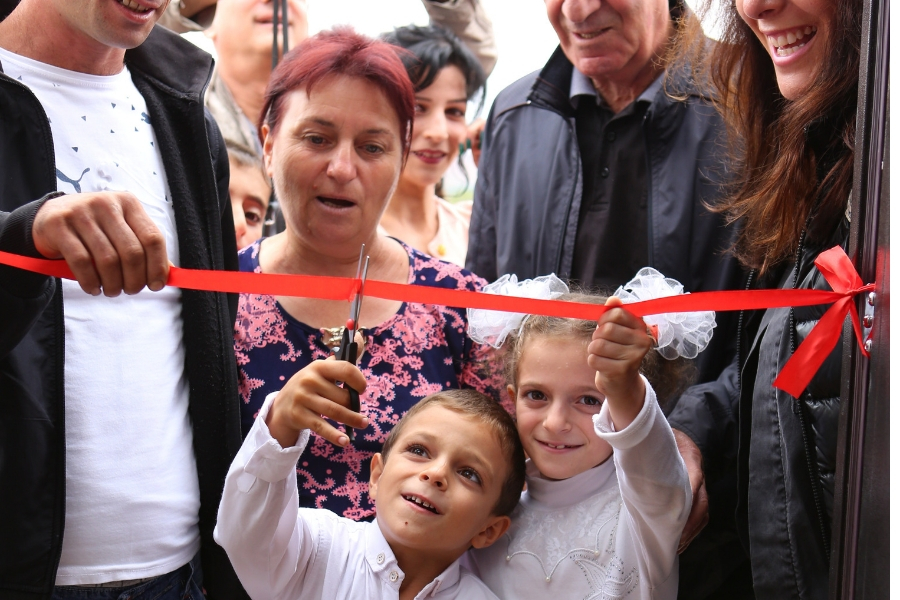
Tufenkian Foundation Gives 3 New Homes to Artsakh Resettlers

Tenkianfoundation – 29/09/18
September27–SezarTatleyan and ArtinAlmajyan, Syrian-Armenian re-settlers in Artsakh, as well as PapagStepanyan who relocated to Artsakh from Armenia, celebrated home openings in Artsakh’s liberated Kashatagh region this week. The 3 homes were built by the Tufenkian Foundation, in the framework of its mission to rebuild and repopulateArtsakh’s borderlands and provide housing and other support to re-settlers.
Representatives of the Tufenkian Foundation, Kashatagh regional administration, local media, as well as Diaspora guests took part in the home openings.
The Tufenkian Foundation started its program aimed at the resettlement of Kashatagh in 2008. Since then, over 100 houses have been built or renovated for re-settlers and current residents of the strategic liberated region. During the past years, the Foundation has mostly focused on more specific needs, giving homes to Syrian-Armenian re-settlers, wounded soldiers, etc, while continuing to rebuild Kashatagh’s uprooted housing infrastructure.
The first home opening took place on September 24, for the family of Syrian-Armenian SezarTatleyan in Berdzor, the administrative center of the Kashatagh region. The young man left Damascus for Armenia in 2003. After several years of struggling to find employment, he decided to move to Artsakh and start a new life here. Now, he is married and has a little daughter. For years, the family didn’t have a home of his own and had to rent a place in Shushi. When Sezar approached the Tufenkian Foundation for housing support, they suggested him to move to Kashatagh, where the Foundation’s housing projects are focused.
The other two housewarming ceremonies took place earlier today. First, in the Getamej village of Southern Kashatagh, the young family of Syrian-Armenian ArtinAlmajyan moved into their new home. 33- year-old Artin, an electrician by trade, was born and grew up in Syria. After having to fight in the Syrian War for nearly 5 years, he moved to Artsakh and settled in the Getamej village. Soon, he married a local woman. Now, Artin is a father to two little children. Before moving into their new home, Artin’s family Artin’s lived in a poorly built house with no kitchen, bathroom, running water, flooring or ceiling. Now, they will live in a large and bright house built by the Tufenkian Foundation.
Finally, PapagStepanyan’s family of five celebrated house warming in Van, one of the southernmost villages of Kashatagh. Papag moved to Artsakh about 20 years ago, together with his brother and parents. Now, both Papag and his brother have families of their own, and they have well settled into village life in Artsakh. Papag works in a persimmon orchard planted (2400 trees, 5 hectares) by the Tufenkian Foundation in the Van village earlier this year.
When the family first arrived to Artsakh, the Kashatagh administration provided them with an old, almost-ruined building to live in. Over the years, the family worked to improve the house, but it was in too poor a condition to be turned into a real home. To help the family, the Tufenkian Foundation has fully rebuilt their home, repairing and renovating all its rooms, building a bathroom and a kitchen, providing them with running water.
Talking about the importance of building homes for Artsakh and resettling the liberated territories, Tufenkian Foundation Executive Director RaffiDoudaklian said “These are our lands. In the early 90s, our heroes gave their lives to liberate these territories, and now, our soldiers risk their lives every day to protect this homeland of ours. It is our collective responsibility to make sure that Kashatagh not just survives, but thrives and blossoms. That’s why we have been rebuilding these borderlands for the past 15 years, and we will continue to do so”.
The 3 home openings coincided with the celebrations of Tufenkian Foundation’s 15th anniversary of working in Artsakh. Launched in 1998, the Tufenkian Foundation expanded its scope to Artsakh in 1993. Since then, it has focused on resettling, rebuilding and developing the liberated regions of Artsakh through construction and renovation of houses, schools and clinics, installing or restoring water supply and irrigation systems, planting orchards and cultivating lands, giving housing support to current residents, new-resettlers, Syrian-Armenian and Lebanese-Armenian refugees and wounded soldiers, as well as ensuring balanced response to the Artsakh situation in international media.


